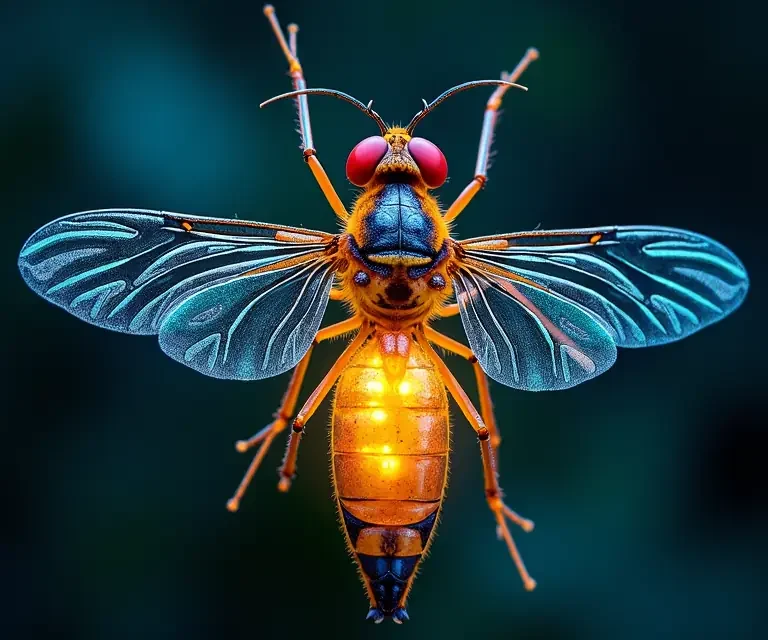For millennia, humans have been captivated by the ethereal glow of fireflies. These twinkling insects, also known as lightning bugs, transform summer nights into scenes of magical wonder. But beyond the romantic allure, firefly bioluminescence is a fascinating example of complex chemistry, evolutionary adaptation, and ecological signaling. This article delves into the science behind this natural phenomenon, exploring the mechanisms, purpose, and current threats facing these remarkable creatures.
What is Bioluminescence?
Bioluminescence is the production and emission of light by a living organism. It’s a form of chemiluminescence, meaning light is produced by a chemical reaction. While fireflies are perhaps the most well-known bioluminescent organisms, this ability isn’t limited to them. It’s found throughout the biological world, particularly in marine animals – think jellyfish, anglerfish, and various bacteria – but also in some fungi, insects, and even a few vertebrates.
The chemical reaction responsible for bioluminescence requires a few key ingredients: a luciferin (a light-emitting molecule), a luciferase (an enzyme that catalyzes the reaction), oxygen, and often a cofactor like ATP (adenosine triphosphate), the energy currency of cells. The specific luciferin and luciferase vary between different bioluminescent organisms, resulting in different colors and intensities of light.
The Chemistry of Firefly Light
Fireflies utilize a particularly well-studied bioluminescent system. Their luciferin, aptly named firefly luciferin, is a small organic molecule. The luciferase, firefly luciferase, acts as a catalyst, speeding up the reaction between luciferin and oxygen. This reaction isn’t a simple oxidation; it’s a complex process that involves several intermediate steps.
Here’s a simplified breakdown:
- Luciferin Activation: Firefly luciferin reacts with ATP in the presence of magnesium ions (Mg2+) to form luciferyl adenylate. This step essentially ‘activates’ the luciferin molecule, preparing it for the light-emitting reaction.
- Oxidation: Luciferyl adenylate then reacts with oxygen, catalyzed by luciferase. This is the core light-producing step.
- Light Emission: This reaction results in the formation of oxyluciferin, carbon dioxide (CO2), and, crucially, light. The light emitted is typically in the yellow-green range of the spectrum (around 550-600 nm), but variations exist between different firefly species.
- Recycling: The oxyluciferin product can be recycled back into luciferin through a separate enzymatic pathway, allowing the firefly to continue glowing.
The efficiency of this reaction is remarkable. Nearly 100% of the energy released during the reaction is emitted as light, with very little heat produced. This contrasts sharply with incandescent light bulbs, which release a significant amount of energy as heat.
Why Do Fireflies Glow? The Purpose of Bioluminescence
The primary purpose of firefly bioluminescence is communication, specifically for attracting mates. However, the specific signaling strategies vary dramatically between species. These strategies can be broadly categorized into several types:
- Flash Patterns: Many firefly species use distinct flash patterns – variations in the length, intensity, and timing of flashes – to identify themselves to potential mates of the same species. These patterns act like a species-specific code. Males typically fly around emitting these patterns, while females, often perched on vegetation, respond with a characteristic flash after a species-specific delay.
- Continuous Glow: Some species, particularly those found in certain parts of Asia, exhibit a continuous glow rather than flashing. This is often seen in females to attract males.
- Synchronous Flashing: Perhaps the most spectacular display is synchronous flashing, where large groups of fireflies coordinate their flashes, creating breathtaking waves of light across fields and forests. The mechanisms behind synchronous flashing are still being investigated, but it’s believed to involve a combination of visual and neural feedback.
- Predatory Deception: While primarily used for mating, bioluminescence can also be used for defense or predation. Some firefly species, notably the Photuris genus, exhibit a particularly sinister behavior: they mimic the flash patterns of females from other species to lure males in, then prey on them. This is known as aggressive mimicry.
The complexity of these signaling systems highlights the evolutionary pressures that have shaped firefly behavior. Successful mate attraction is crucial for reproduction, and the ability to accurately recognize and respond to the signals of conspecifics (members of the same species) is vital.
Beyond Mating: Other Potential Functions
While mate attraction is the dominant function, researchers are exploring other potential roles for firefly bioluminescence.

- Defense Against Predators: The light may serve as a warning signal to potential predators, indicating that the firefly is distasteful or even toxic. Some fireflies contain lucibufagins, defensive steroids that make them unpalatable to birds and other predators.
- Larval Signaling: Firefly larvae, which also exhibit bioluminescence, may use their glow to ward off predators or communicate with each other.
- Illumination: Although not a primary function, the faint glow may provide some degree of illumination, aiding in navigation or foraging.
The Diversity of Fireflies
There are over 2,000 species of fireflies worldwide, distributed across various habitats, from forests and meadows to marshes and urban areas. They belong to the family Lampyridae within the order Coleoptera (beetles). These species exhibit a remarkable range of behaviors, morphologies, and bioluminescent patterns.
Here’s a glimpse into the diversity:
- Geographic Distribution: Fireflies are most abundant in tropical and subtropical regions, but they are also found in temperate zones.
- Habitat Preference: Different species have adapted to different habitats. Some prefer damp, forested areas, while others thrive in open grasslands or near water sources.
- Diet: Most adult fireflies don’t feed, relying on energy reserves accumulated during their larval stage. However, some species do feed on pollen or nectar. Larvae are typically carnivorous, feeding on snails, slugs, and other small invertebrates.
- Bioluminescence Color: While yellow-green is the most common color, some species exhibit orange, red, or even bluish bioluminescence.
Threats to Firefly Populations
Sadly, firefly populations are declining in many parts of the world. This decline is attributed to a number of factors, many of which are directly linked to human activities.
- Habitat Loss: The destruction of forests, meadows, and wetlands for agriculture, urbanization, and development is a major threat. Fireflies require specific habitats for breeding, foraging, and shelter.
- Light Pollution: Artificial light at night disrupts firefly mating behavior. The bright lights interfere with their ability to see and respond to each other’s signals. This is particularly problematic for species that rely on flash patterns for communication.
- Pesticide Use: Insecticides, even those not directly targeting fireflies, can have detrimental effects on their populations. Larvae are particularly vulnerable to pesticide exposure.
- Climate Change: Changes in temperature and precipitation patterns can disrupt firefly life cycles and alter their habitats.
Conservation Efforts
Protecting fireflies requires a multifaceted approach. Here are some steps that can be taken:
- Habitat Preservation: Protecting and restoring firefly habitats is crucial. This includes conserving forests, meadows, and wetlands.
- Reducing Light Pollution: Using shielded outdoor lighting, reducing unnecessary lighting, and promoting dark-sky initiatives can minimize light pollution.
- Sustainable Agriculture: Adopting sustainable agricultural practices that minimize pesticide use can help protect fireflies and other beneficial insects.
- Citizen Science: Participating in citizen science projects, such as firefly counts and habitat monitoring, can help researchers track population trends and assess the effectiveness of conservation efforts.
- Raising Awareness: Educating the public about the importance of fireflies and the threats they face is essential for fostering support for conservation.
The Future of Firefly Bioluminescence
The study of firefly bioluminescence continues to yield new insights. Researchers are exploring the potential applications of firefly luciferase in various fields, including biomedical research, environmental monitoring, and even lighting technology.
For example, luciferase is used as a reporter gene in molecular biology, allowing scientists to track gene expression and study cellular processes. It’s also being investigated as a potential tool for detecting pollutants and monitoring water quality.
However, preserving the natural wonder of firefly bioluminescence requires a commitment to conservation. By understanding the science behind this remarkable phenomenon and addressing the threats facing these fascinating creatures, we can ensure that future generations will continue to be captivated by their magical glow.
Want to learn more about fascinating natural phenomena? Check out the intricate geometry of snowflake formation or the physics behind paper airplanes.
Interested in other historical curiosities? You might enjoy the symbolism of Victorian mourning jewelry or the history of barbering. And for a look at hidden meanings, explore the symbolism of early playing cards.


 The Unexpectedly Consistent Science of Soapmaking: From Ancient Recipes to Modern Chemistry
The Unexpectedly Consistent Science of Soapmaking: From Ancient Recipes to Modern Chemistry  The Curious Physics of Bubbles: More Than Just Soap & Air
The Curious Physics of Bubbles: More Than Just Soap & Air  Color Me Curious: The Surprising Science of Pigments Throughout History
Color Me Curious: The Surprising Science of Pigments Throughout History  The Unexpected Physics of Play: How Toys Teach Us About the Universe
The Unexpected Physics of Play: How Toys Teach Us About the Universe  The Secret Lives of Common Minerals: More Than Just Pretty Rocks
The Secret Lives of Common Minerals: More Than Just Pretty Rocks